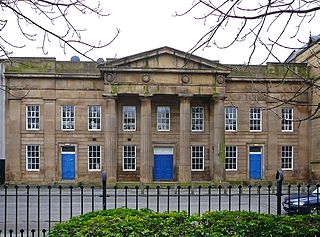
Chorlton-on-Medlock is an inner city area of Manchester, England.

Hulme is an inner city area and electoral ward of Manchester, in Greater Manchester, England, immediately south of Manchester city centre. It has a significant industrial heritage.

The history of Manchester encompasses its change from a minor Lancastrian township into the pre-eminent industrial metropolis of the United Kingdom and the world. Manchester began expanding "at an astonishing rate" around the turn of the 19th century as part of a process of unplanned urbanisation brought on by a boom in textile manufacture during the Industrial Revolution. The transformation took little more than a century.

Ancoats is an area of Manchester, England, next to the Northern Quarter, the northern part of Manchester city centre.

Saint Mary's Hospital is a hospital in Manchester, England. It is part of Manchester University NHS Foundation Trust. Founded in 1790, St Mary's provides a range of inter-related services specifically for women and children. In 1986, St Mary's Sexual Assault Referral Centre was the first sexual assault referral centre (SARC) to open in the UK.
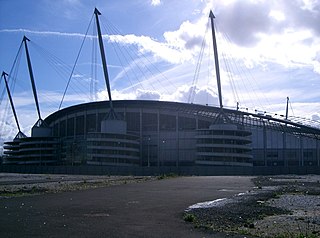
Bradford is a district of east Manchester, in Greater Manchester, England, two miles north east of the city centre. The population at the 2011 census was 15,784. Historically in Lancashire, after the closure of its heavy industries Bradford was for many years an economically deprived area but has undergone regeneration with the building of the City of Manchester Stadium which hosted the 2002 Commonwealth Games and is now home to Manchester City F.C. Bradford is neighboured by Beswick to the south and the two areas are sometimes referred to as Bradford-with-Beswick. The River Medlock and the Ashton Canal run through Bradford.

Manchester Royal Infirmary (MRI) is a large NHS teaching hospital in Chorlton-on-Medlock, Manchester, England. Founded by Charles White in 1752 as part of the voluntary hospital movement of the 18th century, it is now a major regional and national medical centre. It is the largest hospital within Manchester University NHS Foundation Trust, and based on its Oxford Road Campus in South Manchester where it shares a site with the Royal Manchester Children's Hospital, Manchester Royal Eye Hospital and Saint Mary's Hospital as well as several other educational and research facilities. The Hospital is also a key site for medical educational within Manchester, serving as a main teaching hospital for School of Medical Sciences, University of Manchester.

North Manchester General Hospital (NMGH) is a large NHS hospital in Crumpsall, North Manchester, England. It is operated by Manchester University NHS Foundation Trust. There is an accident and emergency unit, together with a maternity unit, high dependency unit and a mental health wing. A plan to rebuild the hospital was announced by Boris Johnson in the 2019 General Election campaign, and in November 2020 a £54 million funding bid for improvement works was made by the Trust, Manchester City Council, and Manchester Health and Care Commissioning.

The Ancoats Hospital and Ardwick and Ancoats Dispensary was a large inner-city hospital located in Ancoats, to the north of the city centre of Manchester, England. It was built in 1875, replacing the Ardwick and Ancoats Dispensary that had existed since 1828. The building is now Grade II listed.
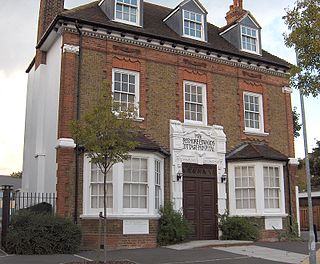
A cottage hospital is a mostly obsolete type of small hospital, most commonly found in the United Kingdom.
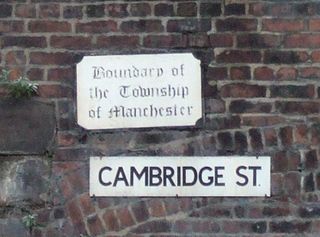
Manchester Township was one of the many townships and chapelries which formed the ancient parish of Manchester within the Salford hundred of Lancashire, England. It included the area of what is now Manchester city centre and the adjoining area of Ancoats.

The University Hospital of South Manchester NHS Foundation Trust is a defunct NHS foundation trust that previously operated Wythenshawe Hospital, a major acute teaching hospital in Wythenshawe, Manchester. Many of the services and facilities previously at Withington Hospital were transferred to Wythenshawe in 2004. It provided services for adults and children at Wythenshawe Hospital and Withington Community Hospital. It runs Buccleuch Lodge Intermediate Care Unit and the Dermot Murphy Centre in Withington, and the Specialised Ability Centre in Sharston.
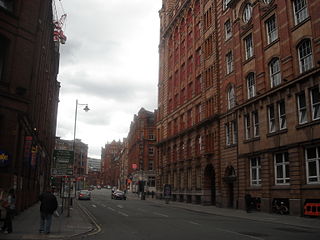
Whitworth Street is a street in Manchester, England. It runs between London Road (A6) and Oxford Street (A34). West of Oxford Street it becomes Whitworth Street West, which then goes as far as Deansgate (A56). It was opened in 1899 and is lined with many large and grand warehouses. It is named after the engineer Joseph Whitworth, whose works once stood along the route. Whitworth Street West runs alongside the viaduct connecting Oxford Road and Deansgate railway stations: beyond Albion Street the Rochdale Canal is on the northern side. On the Albion Street corner is the building once occupied by the Haçienda nightclub at nos. 11–13, as well as the Twisted Wheel Club at no. 6, while further west on the opposite side is the Ritz.
Hannah Brackenbury (1795–1873) was an English philanthropist. She was unmarried and had inherited wealth from James Brackenbury, a solicitor from Manchester, England, who had made money through involvement with the Lancashire and Yorkshire Railway. Sources differ regarding whether James was her father or brother. Believing herself to be the last of the Brackenbury line, which she thought could be traced to Perse Brackenbury, who had married into the family of John Balliol around 1086 AD, she elected to engage in philanthropic endeavours in spheres that had connections to her relatives.

Chorlton Poor Law Union was founded in January 1837 in response to the Poor Law Amendment Act 1834, also known as the New Poor Law. It was overseen by an elected board of 19 guardians representing the 12 parishes in the area it served: Ardwick, Burnage, Chorlton-upon-Medlock, Chorlton with Hardy, Didsbury, Gorton, Hulme, Levenshulme, Moss Side, Rusholme, Stretford, and Withington, all in present day south Manchester, England.

The following is a timeline of the history of the city of Manchester in north west England.
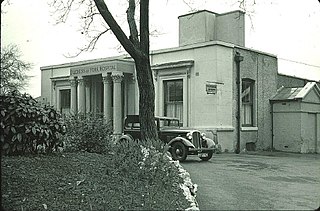
The Duchess of York Hospital was a children's hospital in Manchester.
Voluntary hospitals were created from the eighteenth century in England. In America, Ireland, and Australia, voluntary hospitals were established later. They can be distinguished from municipal hospitals, which were publicly owned, and private hospitals, which were run commercially. They were initially financed by public subscription. A voluntary hospital may also be a charitable hospital.

Salford Royal Hospital is a large university teaching hospital in Pendleton, Salford, England operated by Northern Care Alliance NHS Foundation Trust. It was previously one of the top-performing hospitals in the United Kingdom.

Westhulme Hospital, also known for some time as Westhulme Fever Hospital, was an institution in Oldham, England. At one time a hospital for infectious diseases, it later became a site used by several health-related organisations.



















